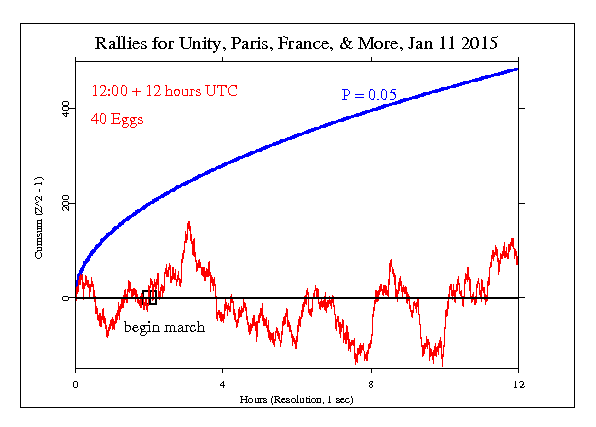Rally for Unity, Paris, Jan 11 2015
Three days after the murders at Charlie Hebdo and in the Jewish grocery, millions of people gathered in solidarity. The streets of Paris were jam packed with an estimated 1.7 million, and other cities in France and in other countries saw similar demonstrations. Even the leaders of some 40 countries marched at the head of the mass demonstration, linked arm in arm. This seemed an event that would express the kinds of shared emotions we see correlated with GCP data deviations. Certainly it was widely broadcast, and there is no doubt the feelings were deep and genuine for most participants.
Specific Hypothesis and Results
The GCP event was set for 12 hours beginning at 12:00 noon UTC. The march was scheduled to begin at 3:00 pm Paris time (14:00 UTC). The result is Chisquare 43270 on 43200 df, for p = 0.406 and Z = 0.239.
Interpretation
The following graph is a visual display of the statistical result. It shows the second-by-second accumulation of small deviations of the data from what’s expected. Our prediction is that deviations will tend to be positive, and if this is so, the jagged line will tend to go upward. If the endpoint is positive, this is evidence for the general hypothesis and adds to the bottome line. If the endpoint is outside the smooth curve showing 0.05 probability, the deviation is nominally significant. If the trend of the cumulative deviation is downward, this is evidence against the hypothesis, and is subtracted from the bottom line. For more detail on how to interpret the results, see The Science and related pages, as well as the standard caveat below.

Standard caveat
It is important to keep in mind that we have only a tiny statistical effect, so that it is always hard to distinguish signal from noise. This means that every success
might be largely driven by chance, and every null
might include a real signal overwhelmed by noise. In the long run, a real effect can be identified only by patiently accumulating replications of similar analyses.
